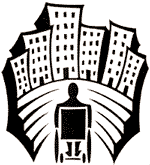|
We have a long way to go before disability is viewed as just another way of being in the world and discrimination ceases. However, we cannot fight the discrimination that people with disabilities face daily until we acknowledge that it is discrimination. To do this we must begin to view disability by means of a "minority model" instead of a "medical model." Here is a comparison of these two views of disability:1
The Medical Model This model gives all the power to the professionals and takes power away from people with disabilities. The sick role in our society is this:
There are many negative results for people with disabilities cast in this "sick role." People may not be given the chance to work or go to school even when they are able and want to; they are seen as always needing social support and help. If a person does not want to co-operate with professionals managing their "case," she or he is se en as rebellious and ungrateful. The sick role blames all the obstacles a person faces on the disability instead of on an unaccommodating environment (eg. it is my problem that nerve damage in my body prevents me from walking and climbing stairs, instead of the community's fault for not providing an alternative to stairs). The person with a disability is seen as a perpetual victim because they are not responsible for their state. Most people with disabilities do not see themselves this way. The Minority Mode
|
| Back | Contents | Next |
